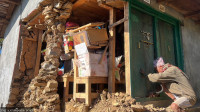Opinion
Diversify borrowing
Nepal needs investment to make economic advancement but overdependence on any single country could land Nepal in the debt trap
Naresh Koirala
The Oli government has declared “Rastriyata—Nationalism and “Arthik Sambriddhi”—Economic Development as its priorities. The Chinese largesse provided under the Belt and Road initiative (BRI) is expected to fuel the economic development part. A look at China’s aid policy and its delivery in developing countries provides some pointers to the difficulty of navigating Rastriyata through the policy maze.
Until 1978, China’s aid agenda had three major elements: ideological (spread of communism in developing countries); isolate the Republic of China (Taiwan) and promote the “People’s Republic” in the world stage.
After Deng Xiaoping opened China to foreign markets in 1978, the export of ideology was dropped from China’s aid agenda. Isolation of Taiwan continued. Deng’s primary focus was on China’s economic development and in expansion of China’s power in the world. He was not interested in ideology. “It does not matter whether the cat is black or white as long as it catches mice”, he said.
The State Council of China published its First Foreign Aid White Paper in 2011 and revised it in 2014. The 2014 White paper largely reaffirmed the foreign aid strategy China had followed after the country’s opening. It says the basic principle of China’s aid is “mutual benefits and ‘Win-Win’ ” and China will not impose any conditions, political or otherwise, on the recipient country (called “zero conditionality” by some analysts).
Reading between the lines
The White Paper does not differentiate between “aid” and “loan”. It lumps both under the term “aid”, creating significant difficulty in tracking the flow of Chinese money.
Under the ‘Win-Win’ strategy, China sees aid as an investment and demands economic returns from it. According to Brad Park, head of prestigious Washington and London based AidData, China wants to get attractive economic returns on its capital.
The “zero conditionality’ allows China to provide huge sums of money to any country as long as the returns are good and they fuel China’s economic ambitions. Congo, Somalia, Zambia, Zimbabwe, all endowed with rich natural resources, are amongst China’s major aid recipients despite their abusive authoritarian governments.
The debt trap
Until now, the dollar amount of Chinese aid to Nepal (all grant) has been miniscule compared to what they have given to other countries. But, if the infrastructure projects touted by the government are to be realized, the “aid” volume could increase to several thousand millions, if not billions and will likely be funded by loans.
These large loans will cause a big shift in the aid dynamic. A review of how other developing countries have dealt with huge Chinese disbursements may highlight some of the pit falls of such borrowing.
The Chinese built a military base in Dijibuti with a loan of $ 1.4 bn under BRI. Dijibuti leased the base to the Peoples Liberation Army for 25 years. China has provided Dijibuti with loans for other development projects in return. Dijibuti runs the risk of being a nation beholden to a single debtor.
Following the end of the Sri Lankan Civil War in May 2009, President Mahinda Rajapaska of Sri Lanka, eager to demonstrate that Sri Lanka was on the path to progress, needed money to finance new large projects. (Not much different from Nepal’s current situation). The Chinese came along, lent $8 bn and built Mattala Rajapaska Airport (and Hambantota Port, a lynchpin in China’s B&R ambition and many other projects).
The airport has become the emptiest modern airport in the world. Designed for 5 million passengers a year, it has only two flights a day. The government of Sri Lanka, unable to service the debt, leased Hambantota Port and its surroundings (15,000 acres) for 99 years to China. Not dissimilar from the Chinese lease of Hong Kong to the British in 1898.
The Chinese flew their flag at the port for about a week, before it was lowered under protests by hundreds of monks. A BBC report quotes a Sri Lankan government economist saying: “There was this sense that China would write us blank cheques”. The reality was different.
China has “weaponised foreign direct investment” says Mohamad Nasheed, the exiled former President of Maldives. Maldives is also grinding under huge Chinese “aid.” Seventy percent of the island nation’s debt is with China and it spends nearly a quarter of its budget in servicing the debt.
Tajikistan surrendered 2,000 acres of its territory to China, unable to service its debt. A report based on interviews with Tajiki people says: “Chinese farmers till Tajiki land and Chinese builders are engaged in large construction projects. Tajikis go to Russia to find work.”
Under a provocative caption “ Why Borrowers on China’s Belt and Road Will Go From Euphoria to Depression”, Tom Holland, former staffer of South China Morning Post writes: “This dynamic – rising debt and insufficient project revenues to service it – is worrying. It suggests local governments will either forego spending in other areas – health, say, or education – or borrow even more to meet their interest payments. The likely consequences are slowing growth, higher interest rates as risk mounts, a runaway rise in debt levels and an even greater dependence on the dominant creditor as other lenders take flight.”
Exercise caution
Nepal needs investment to make economic advancement and China could be a major partner in this. No argument there. But overdependence on China or any single country could land Nepal in the debt trap of a single creditor. The most effective way to avoid the debt trap is to diversify borrowing.
But no donor from industrialized liberal democracies or multilateral agencies will come forth to match China’s loan unless Nepal can demonstrate independence of judiciary and stamp out rampant corruption.
What Nepal needs is a war on political corruption, an unambiguous aid policy in line with our sense of Rastriyata and an in-house team of experts to study the viability of mega projects! Harebrained project announcements from the mountaintop without any supporting back-up work will take us nowhere. Overdependence in one creditor will put our Rastriyata in peril and our long-term economic aspirations in the doldrums.
Koirala is a geotechnical engineer resident in Vancouver, Canada




 16.12°C Kathmandu
16.12°C Kathmandu










